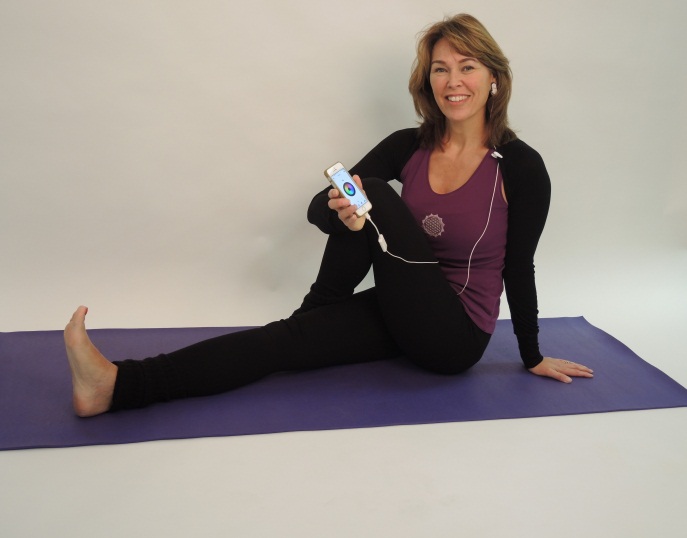Mindfulness, Yoga and Meditation
How the HeartMath techniques can deepen your meditation
There are several reasons why people meditate. Whether you meditate for more inner peace, for self-reflection, more connection with yourself and others or increased spiritual awareness etc., meditation can help you. The increasing stress in the world, however, creates a situation that does not make it easy to be centered and stay balanced. Many people find it difficult to calm down their body and mind. Maybe they fall asleep during meditation or go daydreaming. The different HeartMath techniques teach you to focus on the area around your heart and to connect with your heart. This ensures balance between emotions, mind, body and spirituality. The HeartMath biofeedback equipment shows the effect on your physiology. Through training, your inner noise will fade, allowing you to focus. This brings you to a relaxed but alert state, the state of meditation.
A study of Zen monks found that the more advanced monks tended to have coherent heart rhythms. A study of long-term Buddhist practitioners found that while the practitioners generated a state of “unconditional loving-kindness and compassion,” increases in gamma band oscillation and long-distance phase synchrony in the brain were also observed, which reflects a change in the quality of moment-to-moment awareness. The characteristic patterns of baseline activity in these long-term meditators were found to be different from those of a control group, suggesting that an individual’s baseline state can be improved with practice. Another study of Buddhist monks using the same meditative focus of “loving-kindness and compassion” found an increase in heart rhythm coherence during this practice.
Tulku Thubten Rinpoche, a Tibetan Buddhist Dzogchen Master says, “I find that practicing the HeartMath techniques is self-affirming, with a lot of value. It takes me to a place of very deep quality, deep peace. HeartMath gives pure method, without the need for belief. It can allow anyone to find enlightenment without having to follow a tradition. Many have that concept but no method. HeartMath offers a method. I doubt that there has ever been such on the planet before, or any institute like the Institute of HeartMath. The planet has evolved in intelligence to where people are ready for this now. It’s about pure love. Buddhism teaches that. Pure love is the beginning and the end. In that state science and awareness come together. You can be an agnostic, not believe in God even, and with HeartMath tools realize pure love and come to enlightenment or God.”
Yoga and heart coherence training
Yoga teachers and practitioners are increasingly opting for HeartMath to strengthen the positive effects of yoga postures and to deepen their meditation. Heart coherence training with biofeedback equipment is used by many yoga teachers around the world in their daily lives and work. It is an effective method of stress regulation through the combination of Eastern relaxation techniques with Western technology. The effects of respiratory and meditation exercises on the functioning of the heart, the brain and the autonomic nervous system are immediately visible and provide a powerful learning effect.

In India therapeutic yoga uses the strength of the heart to cure disease. People at the Kaivalyadhama yoga institute in Lonavla, teach patients to breathe slowly and deeply, in a rhythm of 5 seconds in and 5 seconds that equates to 6 breaths per minute. For example, according to the lecturers at this renowned institute, the stress response is reduced, and the healing power of the heart is activated. (see kdham.com/cancer/). For the same reason, the Swedish company Medicare trains yoga teachers to give yoga classes with heart coherence techniques for hospital patients. (see en.mediyoga.com).
Mindfulness and heart coherence training
In 2011 a very interesting study was done in the Antonius hospital in The Netherlands where one group of patients received mindfulness training and another group had heart coherence training. In both interventions significance improvements were found in psychosocial functioning and psychological well-being. In heart coherence training the dropout rate was considerably lower than in the mindfulness group, this may have been due to the fact that the mindfulness intervention required considerably more effort than the heart coherence training. We see in practice that mindfulness and cardiac coherence training is increasingly being combined.
"I thank you all from my heart for getting the chance to use the emWave2 in the meditation project of the teacher training project" long meditation. "It was a great experience for myself and the yogis to work with the device, it was a great guide for them to let the concentration and focus improve and let them relax in the here and now, also to make them aware of what it is like to be in heart coherence. Sometimes I had some problems with the ear sensor, I have thin earlobes, which I solved by moving the sensor upwards on the ear, it was a nice and very good experience for myself to experience the depth of the heart. "
Gunther Van den Bussche
